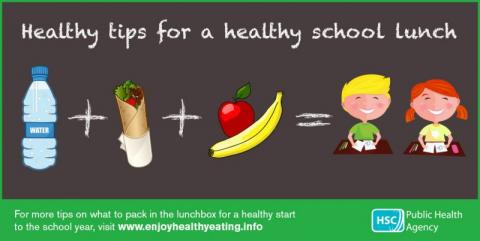Healthy tips for a healthy school lunch

As the new school year approaches, it can be difficult to think up healthy lunch and snack ideas for the children’s packed lunch, so the Public Health Agency (PHA) has some handy advice and tips on choosing a healthier option for the best start to the school year.
The main message is to steer clear of sugary drinks and snacks high in added fat, salt and sugars and to remember that children only need kid-sized portions.
Caroline Bloomfield, Health and Social Wellbeing Improvement Manager at the PHA, said ‘There are many foods available in our supermarkets that are marketed for lunchboxes. These foods are often high in fat, salt and sugars. It can be confusing: however, picking the healthier option isn’t just good for nourishment, it can also help with pupils’ concentration and behaviour in the classroom.
“Involve your kids in making up their lunchboxes too, as encouraging children and talking to them about choosing healthier foods is an important step in establishing good eating habits that will benefit them throughout their lives, helping them to stay a healthy weight.”
Both schools and parents have an important role to play in ensuring children have healthy choices for both breaks and lunches.
Nursery schools, playgroups and primary schools will receive information from the PHA and safefood on healthy eating in schools. They can also be seen on our website atwww.publichealthagency.org/publications.
Caroline continued: “Young children have a small capacity for food but also have high energy and nutrient requirements. Three meals a day are often not enough to provide all the nutrients they require, therefore healthy snacks between meals are very important. Including fruit and vegetables as snacks for morning break will also help them get their five a day.
“Bread snacks can help meet these extra energy needs so a small roll, pitta bread or bread sticks can be a good inclusion in the lunchbox. Thinly spread the bread with a little margarine, low-fat spread or butter and avoid using sugary spreads like jam, honey and chocolate spread which can be harmful to teeth.”
It’s also important that children drink enough during the day so that they don’t become dehydrated and tired. Water and milk are the most suitable for children, and sugary drinks, including fruit juices and smoothies, should be avoided as these can cause tooth decay, especially when taken between meals.
Helpful tips
Drinks:
- What to pack – Water: tap water or unflavoured, still, bottled water. Milk: all whole, semi-skimmed or skimmed unflavoured milk.
- What not to pack – Fruit juices (including pure fruit juice), smoothies, sparkling water, squash or fizzy drinks, even those labelled ‘no added sugar’, ‘diet’ or ‘zero’.
Fruit and veg:
- What to pack – Any fresh fruit and vegetables, or fruit packed in pots or tins in fruit juice but not in syrup. A portion could be one medium sized piece of fruit, eg: apple, orange, banana, pear; a cup of grapes, cherries or berries; a cereal bowl of salad, eg lettuce, tomatoes, cucumber and celery.
- What not to pack – Fruit tinned in syrup, dried fruit (eg raisins, sultanas) and processed fruit bars (eg fruit winders, fruit flakes etc). These are high in sugar and can cause tooth decay.
Bread:
- What to pack – White or wholemeal bread, rolls or baguettes, toast, plain bagels, wheaten, soda, potato or pitta bread, spread thinly with a little margarine, low-fat spread or butter; plain bread sticks or crackers, a small sandwich with a sugar-free filling such as tomato, tuna, chicken, cheese etc.
- What not to pack – Sugary spreads, including jam, honey, marmalade or chocolate spread as these are harmful to teeth. Peanut butter is high in fat and salt so is not recommended; many schools are nut-free zones. Stay clear of cereal bars, or sweetened breads and pastries, eg pancakes, scones (plain and fruit), fruit bread, croissants and Danish pastries as these can contain a lot of sugar and/or fat and salt.
For more information refer to the leaflet Are you packing a healthy lunch? atpha.site/packedlunch and for more tips and ideas visit pha.site/healthylunch
